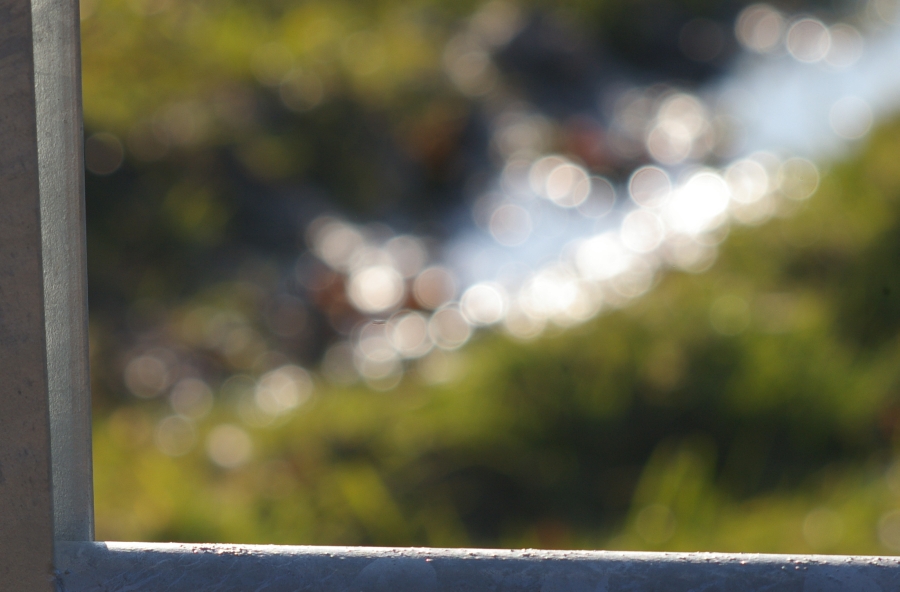| View previous topic :: View next topic |
| Author |
Message |
scsambrook


Joined: 29 Mar 2009
Posts: 2167
Location: Glasgow Scotland
Expire: 2011-11-18
|
 Posted: Fri Apr 03, 2009 2:49 pm Post subject: Meyer Telemegor 180mm f5.5 Posted: Fri Apr 03, 2009 2:49 pm Post subject: Meyer Telemegor 180mm f5.5 |
 |
|
scsambrook wrote:
I recently acquired an M42 fitting Meyer Telemegor 180mm f5.5, the black version with silver flutes on the focus ring made in the mid 1960s. It has turned out to be a much more interesting lens than I expected, not least because of how it handles highlights and defocussed images at different apertures.
According to Arthur Cox's book "Photographic Optics" (13th edn, London, 1966: p.459) it's of telephoto construction using just two pairs of cemented doublets with the iris closer to the rear pair. This design is, apparently, similar to some older Dallmeyer, Schneider and Taylor Taylor Hobson types, as well as the Komura 200mm, 300mm and 400mm ones from the 1960s. So, it's very much an old-world type with only four air/glass surfaces and nothing by way of multi-coatings or exotic glasses.
The iris gives as nearly perfect a circular aperture as one could hope for, but the behaviour on stopping down suggests that the shape of the diaphragm is by no means the only important factor in defocussed image quality. Look at the first pair of images of the daffodils: picture 1 is at f5.5, picture 2 is at f11

[/i]
Usually, the defocussed image is "smoother" at wide apertures, but here we see the reverse - I feel the wide-open image is more distracting.
At the same time, the image before the point of focus (third flower from left) shows a rather ethereal quality at f5.5 - the highlights running smoothly into the shadows, something which can be seen better in the next pair of images: the first is at f5.5, the second at f11.


The horizontal metal bar at the bottom of the picture shows how even focussed highlights are spread, and once again we see the softened background at a smaller aperture is less confusing to the eye. Note also the "double edges" to the circular diffused points of light, particularly at f5.5.
The lens is perfectly clean, so the nature of the diffusion must be in the design. Perhaps in the search for ever higher image quality lens designers have robbed us of other qualities which enhance "pictures" as opposed to "images". I wonder if I take a skylight/UV filter and attach a circular black adhesive dot to the centre whether I'll be on the way to creating the type of image given by the old Leitz Thambar? An easy enough thing to do!
I have to make spend some more time with this intriguing little lens (only 115cms/4.75 inches long and feather-light), particularly shooting against-the-light. Focussing at f5.5 is quite easy, although closing down to f8 actually makes things better as the diffusion effect vanishes.
These were taken with a Pentax K100d: in-camera sharpening set at +1, everything else at at null settings. The first pair are whole-frames, the second crops of about 50% the original. No post-processing.
_________________
Stephen
Equipment: Pentax DSLR for casual shooting, Lumix G1 and Fuji XE-1 for playing with old lenses, and Leica M8 because I still like the optical rangefinder system. |
|
| Back to top |
|
 |
wariag

Joined: 08 Dec 2008
Posts: 59
Location: Lodz, Poland
|
 Posted: Fri Apr 03, 2009 3:31 pm Post subject: Posted: Fri Apr 03, 2009 3:31 pm Post subject: |
 |
|
wariag wrote:
Hi,
the diffusion of the highlights is the effect of spherical aberration.
Telemegor design is derived from the first "classic" telephoto lens - Emil Busch "Bis-Telar"
/by accident I've found, that Bis-Telar formula was calculated by Polish optician/photographer Józef Świtkowski (1876 - 1942) - most sources say that it was designed by K. Martin in 1905).
It's very old design now, more than 100 years old.
With some exceptions, all lenses in Telemegor line give "soft focus" effect, and for "pixel sharpness" on dSLR they need to be stepped down well.
For my Telemegors i've found following settings for "razor sharp" images:
Telemegor 180/5.5 - f8-f11
Telemegor 250/5.5 - f11-f16
Telemegor 400/5.5 - f11-f16
_________________
analog system: Pentax K & M42
digital sytem: Nikon 1 (CX) & Samsung NX (APS-c)
optics: mostly USSR and GDR made primes; some Japanese, Korean and other nationality
primes:
8/2.8, 14/2.8, 20/2.8(AF), 30/2(AF), 50/1.4-3.5, 80/2, 90/2.8, 100/2.8, 135/2.8-3.5, 200/3.5-4, 300/4-5.5, 436/5.5, 600/7.5
zoom:
28-100/4, 35-70/2.5-3.5, 70-150/3.5, 70-200/2.8, 80-200/4. |
|
| Back to top |
|
 |
scsambrook


Joined: 29 Mar 2009
Posts: 2167
Location: Glasgow Scotland
Expire: 2011-11-18
|
 Posted: Fri Apr 03, 2009 4:06 pm Post subject: Posted: Fri Apr 03, 2009 4:06 pm Post subject: |
 |
|
scsambrook wrote:
| wariag wrote: |
Hi,
the diffusion of the highlights is the effect of spherical aberration.
Telemegor design is derived from the first "classic" telephoto lens - Emil Busch "Bis-Telar"
/by accident I've found, that Bis-Telar formula was calculated by Polish optician/photographer Józef Świtkowski (1876 - 1942) - most sources say that it was designed by K. Martin in 1905).
It's very old design now, more than 100 years old.
With some exceptions, all lenses in Telemegor line give "soft focus" effect, and for "pixel sharpness" on dSLR they need to be stepped down well.
For my Telemegors i've found following settings for "razor sharp" images:
Telemegor 180/5.5 - f8-f11
Telemegor 250/5.5 - f11-f16
Telemegor 400/5.5 - f11-f16 |
Yes- it's certainly sharp enough at f8 and very crisp indeed at f11, although it's the picture-making possibilities at full aperture that are intriguing me at the moment.
Thanks for the historical background on the Bis-Telar computation - I wasn't aware of its Polish ancestry. Could you let me know what your source of information was? I don't read Polish, but it will be handy to have the information for referencing.
_________________
Stephen
Equipment: Pentax DSLR for casual shooting, Lumix G1 and Fuji XE-1 for playing with old lenses, and Leica M8 because I still like the optical rangefinder system. |
|
| Back to top |
|
 |
luisalegria


Joined: 07 Mar 2008
Posts: 6602
Location: San Francisco, USA
Expire: 2018-01-18
|
 Posted: Fri Apr 03, 2009 4:12 pm Post subject: Posted: Fri Apr 03, 2009 4:12 pm Post subject: |
 |
|
luisalegria wrote:
Thank you for a most interesting note.
I have all the Telemegors save the 150/5.5, and till now I have not noticed the details of the out-of-focus behavior, just that the Telemegor line was generally disappointing. Now that you mention it, it certainly seems to be so. I just missed purchasing a 16"/f:7 Busch Telar also, which should have been interesting.
Some other comments on your post and Wariag's -
- The Telemegor 300 seems to be an exception to the rule, mine is quite sharp wide-open, by my standards anyway.
- The Komuras are a mixed bag on sharpness, but they don't really seem to resemble Telemegor performance. I have the 200, 300, and 400. The 200 is adequate, the 300 is less so, the 400 is excellent wide-open.
_________________
I like Pentax DSLR's, Exaktas, M42 bodies of all kinds, strange and cheap Japanese lenses, and am dabbling in medium format/Speed Graphic work. |
|
| Back to top |
|
 |
wariag

Joined: 08 Dec 2008
Posts: 59
Location: Lodz, Poland
|
 Posted: Fri Apr 03, 2009 6:02 pm Post subject: Posted: Fri Apr 03, 2009 6:02 pm Post subject: |
 |
|
wariag wrote:
| scsambrook wrote: |
Yes- it's certainly sharp enough at f8 and very crisp indeed at f11, although it's the picture-making possibilities at full aperture that are intriguing me at the moment.
Thanks for the historical background on the Bis-Telar computation - I wasn't aware of its Polish ancestry. Could you let me know what your source of information was? I don't read Polish, but it will be handy to have the information for referencing. |
I've found this information in brief biographic note about J.Świtkowski:
http://www.foto-info.pl/witkowski-j-zef-1876-1942.html
I want to search for more information about this "incident" in his life, as it's more than quite interesting (life of Świtkowski was definitely not boring, because he is far more known as authority in parapsychology occultism, as well as musician  ). ).
And about full aperture - such "soft" lenses are very useful to create interesting picture of something which would be just too boring with the usual "sharp" lens  . .
_________________
analog system: Pentax K & M42
digital sytem: Nikon 1 (CX) & Samsung NX (APS-c)
optics: mostly USSR and GDR made primes; some Japanese, Korean and other nationality
primes:
8/2.8, 14/2.8, 20/2.8(AF), 30/2(AF), 50/1.4-3.5, 80/2, 90/2.8, 100/2.8, 135/2.8-3.5, 200/3.5-4, 300/4-5.5, 436/5.5, 600/7.5
zoom:
28-100/4, 35-70/2.5-3.5, 70-150/3.5, 70-200/2.8, 80-200/4. |
|
| Back to top |
|
 |
wariag

Joined: 08 Dec 2008
Posts: 59
Location: Lodz, Poland
|
 Posted: Fri Apr 03, 2009 6:13 pm Post subject: Posted: Fri Apr 03, 2009 6:13 pm Post subject: |
 |
|
wariag wrote:
| luisalegria wrote: |
Thank you for a most interesting note.
I have all the Telemegors save the 150/5.5, and till now I have not noticed the details of the out-of-focus behavior, just that the Telemegor line was generally disappointing. Now that you mention it, it certainly seems to be so. I just missed purchasing a 16"/f:7 Busch Telar also, which should have been interesting.
(...). |
I've 27cm f7 Bis-Telar with M-42 adapter - very soft until f12, it's pretty alike Telemegor 250/5.5. The 260/7,5 Busch Rapid-Aplanat is a bit sharper, but bis-telar is more handy. Still, it's fun to use 100+ years old lenses with APS-C sensor with acceptable results 
_________________
analog system: Pentax K & M42
digital sytem: Nikon 1 (CX) & Samsung NX (APS-c)
optics: mostly USSR and GDR made primes; some Japanese, Korean and other nationality
primes:
8/2.8, 14/2.8, 20/2.8(AF), 30/2(AF), 50/1.4-3.5, 80/2, 90/2.8, 100/2.8, 135/2.8-3.5, 200/3.5-4, 300/4-5.5, 436/5.5, 600/7.5
zoom:
28-100/4, 35-70/2.5-3.5, 70-150/3.5, 70-200/2.8, 80-200/4. |
|
| Back to top |
|
 |
scsambrook


Joined: 29 Mar 2009
Posts: 2167
Location: Glasgow Scotland
Expire: 2011-11-18
|
 Posted: Fri Apr 03, 2009 10:16 pm Post subject: Posted: Fri Apr 03, 2009 10:16 pm Post subject: |
 |
|
scsambrook wrote:
| wariag wrote: |
| scsambrook wrote: |
Yes- it's certainly sharp enough at f8 and very crisp indeed at f11, although it's the picture-making possibilities at full aperture that are intriguing me at the moment.
Thanks for the historical background on the Bis-Telar computation - I wasn't aware of its Polish ancestry. Could you let me know what your source of information was? I don't read Polish, but it will be handy to have the information for referencing. |
I've found this information in brief biographic note about J.Świtkowski:
http://www.foto-info.pl/witkowski-j-zef-1876-1942.html
I want to search for more information about this "incident" in his life, as it's more than quite interesting (life of Świtkowski was definitely not boring, because he is far more known as authority in parapsychology occultism, as well as musician  ). ).
And about full aperture - such "soft" lenses are very useful to create interesting picture of something which would be just too boring with the usual "sharp" lens  . . |
Many thanks for that info, Wariag - Switkowski sounds to have been an interesting man. And I agree about "soft" lenses!
_________________
Stephen
Equipment: Pentax DSLR for casual shooting, Lumix G1 and Fuji XE-1 for playing with old lenses, and Leica M8 because I still like the optical rangefinder system. |
|
| Back to top |
|
 |
|
|
|
You cannot post new topics in this forum
You cannot reply to topics in this forum
You cannot edit your posts in this forum
You cannot delete your posts in this forum
You cannot vote in polls in this forum
|
